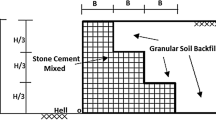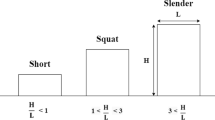Abstract
The reinforced concrete cantilever retaining walls (RCCRWs) are among the most commonly used type of structures to support the soil in civil engineering applications. In the conventional trial and error design of RCCRWs, which are based on engineering experiences and literature reviews, the preliminary dimensions of the wall are selected by considering the wall height only. However, it is known that the properties of backfill soil and surcharge loads also affect the dimensions of the wall. Therefore, in order to take into account the effects of the backfill soil properties and surcharge loads in addition to the height of the wall, a new regression-based approach is developed for predicting the preliminary dimensions of T-shaped RCCRWs. For this aim, a total of 375 optimization analyses are carried out for the optimum design of RCCRWs resting on soil with high bearing capacity by using the artificial bee colony (ABC) algorithm. Based on these calculated optimum solutions, the regression equations are developed for preliminary dimensioning of the T-shaped RCCRWs by using multiple regression analyses. Moreover, a set of 15 random problems are generated to assess prediction ability of the proposed regression equations, and their optimum dimensions are calculated by ABC algorithm and then these calculated dimensions are compared with the preliminary dimensions estimated by the proposed regression equations. From this comparison, it is observed that the maximum difference between the calculated and the estimated wall dimensions is only 6.2%. This means that the proposed preliminary dimensioning regression equations are capable of predicting dimensions that are close enough to the optimum dimensions. Therefore, for the most economical design of the T-shaped RCCRWs resting on soil with high bearing capacity, the predicted dimensions, which are supplied by the proposed regression equations, can be used as a good starting point when an optimization technique or a conventional trial and error method is employed.







Similar content being viewed by others
References
Ahmadi-Nedushan B, Varaee H (2009) Optimal design of reinforced concrete retaining walls using a swarm intelligence technique. In: The first international conference on soft computing technology in civil, structural and environmental engineering, pp 1–12
Akay B, Karaboga D (2012) A modified artificial bee colony algorithm for real-parameter optimization. Inf Sci 192:120–142
American Concrete Institute (2005) Building code requirements for structural concrete and commentary (ACI 318M-05). American Concrete Institute
Aydoğdu I, Akin A, Saka MP (2016) Design optimization of real world steel space frames using artificial bee colony algorithm with levy flight distribution. Adv Eng Softw 92:1–14
Boddula S, Eldho T (2018) Groundwater management using a new coupled model of meshless local Petrov-Galerkin method and modified artificial bee colony algorithm. Comput Geosci 22(3):657–675
Bolaji AL, Khader AT, Al-Betar MA, Awadallah MA (2013) Artificial bee colony algorithm, its variants and applications: a survey. J Theor Appl Inform Technol 47(2):434–459
Bowles J (1997) Foundation analysis and design. Civil engineering series. McGraw-Hill, New York
Budhu M (2008) Foundations and earth retaining structures
Camp CV, Akin A (2011) Design of retaining walls using big bang–big crunch optimization. J Struct Eng 138(3):438–448
Chakraborty A, Goswami D (2017) Prediction of slope stability using multiple linear regression (mlr) and artificial neural network (ann). Arab J Geosci 10(17):385
Dağdeviren U, Kaymak B (2018) Investigation of parameters affecting optimum cost design of reinforced concrete retaining walls using artificial bee colony algorithm. J Faculty Eng Archit Gazi Univ 33(1):239–253
Das BM (2016) Principles of foundation engineering, Eighth Ed
Deb K (2000) An efficient constraint handling method for genetic algorithms. Comput Methods Appl Mech Eng 186(2-4):311– 338
Gandomi AH, Kashani AR, Roke DA, Mousavi M (2017) Optimization of retaining wall design using evolutionary algorithms. Struct Multidiscip Optim 55:809–825
Greco A, Pluchino A, Cannizzaro F (2019) An improved ant colony optimization algorithm and its applications to limit analysis of frame structures. Eng Optim 51(11):1867–1883
Ghazavi M, Bonab S (2011) Optimization of reinforced concrete retaining walls using ant colony method. 3rd International Symposium on Geotechnical Safety and Risk (1996): 297– 305
Ghazavi M, Salavati V (2011) Sensitivity analysis and design of reinforced concrete cantilever retaining walls using bacterial foraging optimization algorithm. In: 3rd international symposium on geotechnical safety and risk, pp 307–314
Jafrasteh B, Fathianpour N (2017) Optimal location of additional exploratory drillholes using afuzzy-artificial bee colony algorithm. Arab J Geosci 10:213
Karaboga D (2005) An idea based on honey bee swarm form numerical optimization. Technical Report TR06, Erciyes University, Turkey
Karaboga D, Akay B (2011) A modified artificial bee colony (ABC) algorithm for constrained optimization problems. Appl Soft Comput 11(3):3021–3031
Karaboga D, Basturk B (2007) Artificial bee colony (ABC) optimization algorithm for solving constrained optimization. Lnai 4529:789–798
Karaboga D, Basturk B (2008) On the performance of artificial bee colony (ABC) algorithm. Appl Soft Comput 8(1):687–697
Kaveh A, Abadi ASM (2011) Harmony search based algorithms for the optimum cost design of reinforced concrete cantilever retaining walls. Int J Civil Eng 9(1):1–8
Kaveh A, Behnam AF (2013) Charged system search algorithm for the optimum cost design of reinforced concrete cantilever retaining walls. Arab J Sci Eng 38:563–570
Kaymak B (2019) Parameter analysis of bacterial foraging optimization algorithm for least weight design of truss structures. Süleyman Demirel University Journal of Natural and Applied Sciences 23(2):24–38
Ma C, Yu T, Van Lich L, Quoc Bui T (2017) An effective computational approach based on XFEM and a novel three-step detection algorithm for multiple complex flaw clusters. Comput Struct 193:207–225
Pei Y, Xia Y (2012) Design of reinforced cantilever retaining walls using heuristic optimization algorithms. Procedia Earth and Planetary Science
Sarıbaş A, Erbatur F (2003) Optimization and sensitivity of retaining structures. J Geotech Eng 122 (8):649–656
Sharma LK, Singh TN (2018) Regression-based models for the prediction of unconfined compressive strength of artificially structured soil. Engineering with Computers
Sheikholeslami R, Khalili BG, Sadollah A, Kim J (2016) Optimization of reinforced concrete retaining walls via hybrid firefly algorithm with upper bound strategy. KSCE J Civ Eng 20(6):2428– 2438
Song X, Gu H, Tang L, Zhao S, Zhang X, Li L, Huang J (2015) Application of artificial bee colony algorithm on surface wave data. Comput Geosci
Sonmez M (2018) Performance comparison of metaheuristic algorithms for the optimal design of space trusses. Arab J Sci Eng 43(10):5265–5281
Sun SH, Yu TT, Nguyen TT, Atroshchenko E, Bui TQ (2018) Structural shape optimization by IGABEM and particle swarm optimization algorithm. Engineering Analysis with Boundary Elements 88:26–40
Vargas DEC, Lemonge ACC, Barbosa HJC, Bernardino HS (2019) Differential evolution with the adaptive penalty method for structural multi-objective optimization. Optim Eng 20(1):65–88
Venkatramaiah C (2016) Geotechnical engineering. Third Edition, New Age International Publishers
Wang C, Yu T, Curiel-Sosa JL, Xie N, Bui TQ (2019a) Adaptive chaotic particle swarm algorithm for isogeometric multi-objective size optimization of FG plates. Struct Multidiscip Optim 60(2):757–778
Wang C, Yu T, Shao G, Nguyen TT, Bui TQ (2019b) Shape optimization of structures with cutouts by an efficient approach based on XIGA and chaotic particle swarm optimization. European Journal of Mechanics, A/Solids 74:176–187
Yılmaz N, Temel Gencer C (2019) Integration of sensor vision capabilities on UAV flight route optimization: a linear model and a heuristic algorithm proposal. J Fac Eng Archit Gazi Univ 34:1917–1928
Yoon GL, Kim BT, Jeon SS (2005) Empirical correlations of compression index for marine clay from regression analysis. Canadian Geotechnical Journal
Zhang Y, Gong C, Fang H, Su H, Li C, Da Ronch A (2019) An efficient space division–based width optimization method for RBF network using fuzzy clustering algorithms. Struct Multidiscip Optim 60(2):461–480
Author information
Authors and Affiliations
Corresponding author
Ethics declarations
Conflict of interest
The authors declare that they have no conflict of interest.
Replication of results
The optimization algorithm and the design details of RCCRWs used the study are given in Sections 2, 3, and 4. The data set used in the developed regression models for estimation of preliminary dimensions of the RCCRWs is obtained from a total of 375 optimization problem results using the artificial bee colony algorithm, and the data set is given in the Supplementary Table 1. Also, 15 different data set used to test and verify the proposed regression models are given in the Supplementary Table 2.
Additional information
Responsible Editor: Mehmet Polat Saka
Publisher’s note
Springer Nature remains neutral with regard to jurisdictional claims in published maps and institutional affiliations.
Electronic supplementary material
Rights and permissions
About this article
Cite this article
Dagdeviren, U., Kaymak, B. A regression-based approach for estimating preliminary dimensioning of reinforced concrete cantilever retaining walls. Struct Multidisc Optim 61, 1657–1675 (2020). https://doi.org/10.1007/s00158-019-02470-w
Received:
Revised:
Accepted:
Published:
Issue Date:
DOI: https://doi.org/10.1007/s00158-019-02470-w




